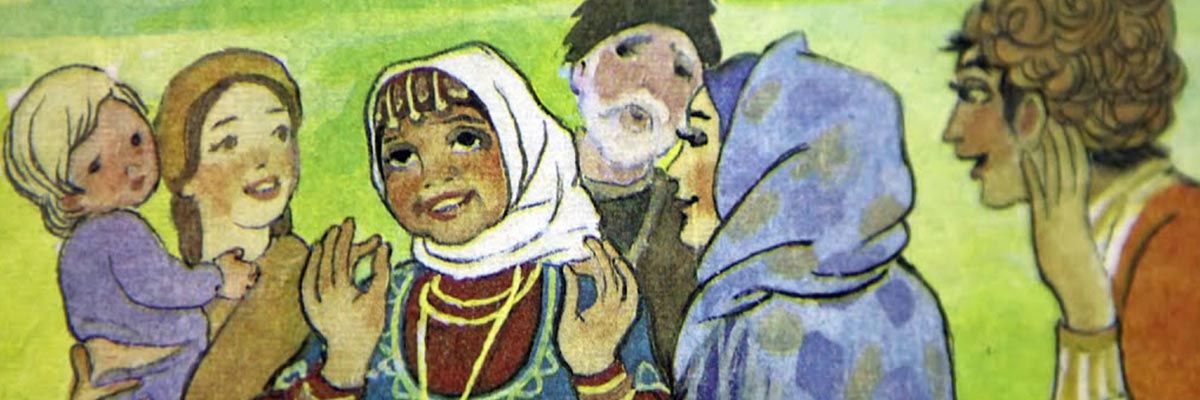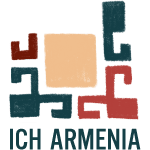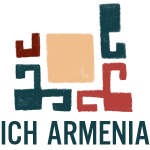
The festive folklore embraces the songs and dance songs which are performed on popular Armenian holidays: New Year, Christmas, Ter’undez, Barekendan, Tsaghkazard (Palm Sunday), Easter, Vardavar (Transformation) and others. Furthermore, each festivity was provided with songs in tune with the nature of the holiday. New Year songs are full of good wishes for the prosperity of the family, and Ter’undez and Barekendan songs were about love and enchantment, and charms against the evil. Easter songs emphasized the fertility of the fields and meadows, and the Hambartsum or casting of lots of songs was performed while holding a draw to forecast the future for young girls. In Vardavar songs merrymaking and amorous coquetry prevailed, etc.
Everyone, young and old, took part in popular festivities, in singing and dancing, which is why the holidays transformed into all-embracing pageantry and helped to pass on to future generations our songs and dances and popular rituals.
Daily family life-related folklore is predominantly about love songs. Love songs most vividly reflect and accentuate the buoyancy of the populace. They convey a reverence for women and their beauty or can conjoin nature and human sentiments. Love songs are created and performed by either girl, or young men, or alternately by both, through dialogues, and often with the help of spontaneous plays. The love theme is also present in workers’ songs, émigré songs, lullabies, etc.
Workers’ songs of the Armenian people are among the oldest types of poetic folklore. For the most part, they contain glorification of work instruments. The latter are either for domestic use, i.e. pertaining to everyday life (milk churning pot, mortar, spinning wheel, spindle, etc.), or related to the field works (ox, cart, wooden plough, cow, buffalo, etc).
Songs related to handicrafts make a separate group. Both domestic lives related and farming/crafts related songs not only praise instruments of labourers and craftsmen but also elicit them as the only means of livelihood and hope for the labourer and his family, capable of sharing their hardships through darker days.
Traditional Armenian merrymaking and satirical songs reflect the infinite cheerfulness of our people, its ability to overcome hardships with the help of laughter and humour. They can pointedly exaggerate a loss of petty and unimportant things like shoes or a hen, to ridiculous proportions. Even songs of spinsters (“Tag taneyeen, taneyeen” {I wish somebody married me}, “Qarsoun taris lratsav” {I’m already forty}) manifest to the lifestyle full of good humor.
The folklore of the Armenian people is the artistic reflection of its lifestyle. Our nation has seen times of invasions, mass emigrations and displacements. And émigré songs have become an indispensible part of its life. They either describe the hard life of those who live and work far from their homeland, or are farewell songs of the mother who blesses her son before his departure to foreign shores, or are confessions of love for the family members, and of homesickness, addressed to birds and breezes.
Popular Armenian military and soldiers’ songs are devoted to various historic events (the Russian-Persian and Russian-Turkish wars, the national liberation movement) and their heroes. Military songs mainly reflect instances of war battles (Russian-Persian, Russian-Turkish, the World Wars I and II) or of the struggle for national independence, with the glorification of their heroes, whereas soldiers’ songs are about the sorrowful and cheerless sentiments of those conscribed in the Tsarist Army in Russia.
Urban poetic folklore, unlike the rural one, originated in more recent times. They are moulded in literary Armenian or the popular parlance and prevail mainly in urban environments. They have few varieties, and to some extent, they bear the hallmark of authored pieces.
“Hiren”-s and “antouni”-s are creations of urban poetic folklore.
“Hiren” is a type of a poem popular in early medieval folklore, with an authentic Armenian structure which contains 15 syllables (7+8). Poems invented to that extent were called by their native names. Songs written particularly in that meter were called “hiren”-s. Narekatsi, Shnorhali, Frik and other Middle Age poets wrote their works in the hiren meter.
“Antouni” is the name of popular Armenian songs, that contain stanzas of 4, 6 or more lines, and are predominantly about émigré life. They were originally created in Middle Armenian and were popular in the province of Akn.
Dance songs, too, date back to pre-historic times and are closely related to various popular rituals and festivities. By their content, dance songs are grouped into work-related ones, military ones, amorous ones, daily life related, etc. They are mostly group dance songs – chain dances accompanied by group or duo singing, and sometimes combining both solo singing and solo dancing.
A separate group consists of Armenian folk children’s folklore. According to the bearers, they are: songs related to child care (lullabies, bath, baby play և walking songs), live in an adult environment, և children’s songs (songs, caricatures, songs dedicated to nature, wildlife, celestial lights, playwright, choir horse riding և other types of songs). They live in a children’s environment. Some of the children’s folklore works have lost their original function, passed from adults to children. These are songs devoted to nature, or the celestial bodies, as well as various ceremonial expressions about droughts, or about the casting of lots, like “jangulum” songs, etc.
The function of a particular folk type (that is the environment it is performed in, or the aim it pursues) is of paramount importance for its survival. If the aim is (and keeps on being ) important for the environment, then the given type or genre will persevere. If the goal plays an important role for the environment (և continues to play), then the genre-type lifestyle is guaranteed.
Living mainly folklore species that have practical value:
1. a) in children’s games (counting-out songs, play songs, wordplays, tongue twisters, etc),
b) at children’s “rituals” (“jangulums” as a component of game rituals),
2. at wedding and burial rituals (poetic ceremonial folklore – wedding, birth, baptism, funeral),
3. at calendrical festive rituals (New Year, Ter’undez, Hambardzum, Vardavar, etc),
4. in popular parlance – mainly popular aphoristic expressions, structured patterns (fables, proverbs, curse spells, blessings, good wishes, caress words, swearwords, etc) that are used in everyday spoken idiom to make the speach more expressive or to affect the environment with the power of words,
5. at get-togethers, as popular means of a pastime (jokes, brain teasers, tongue twisters).


